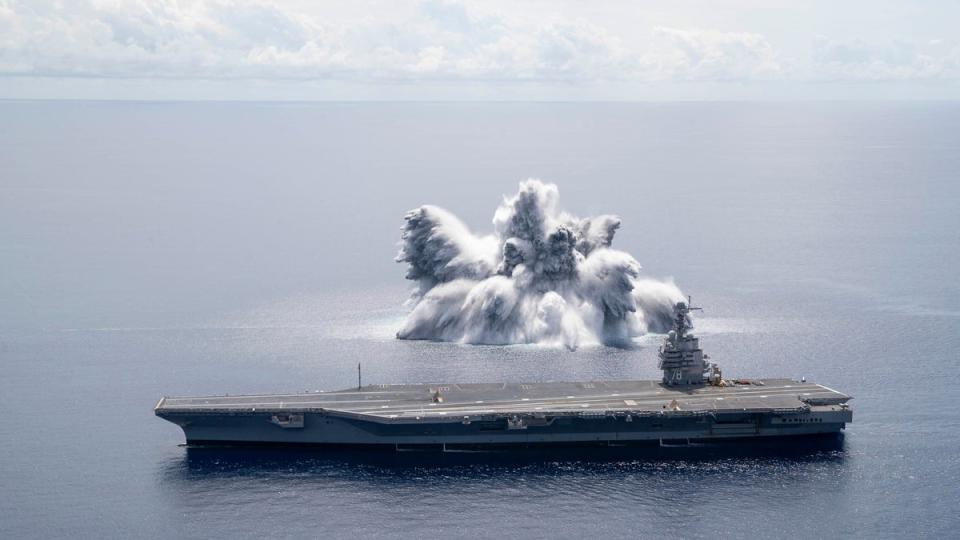USS Gerald R Ford: What we know about world’s biggest warship on first US mission

The US Navy’s most advanced warship – and the world’s biggest – created a buzz as it set sail for its first deployment this week, a milestone for an ambitious plan to modernise the American fleet of aircraft carriers that has faced criticism amid delays and technical mishaps.
The USS Gerald R Ford left for the world’s largest naval base in Norfolk, Virginia, to join vessels of countries like France, Germany and Sweden for various exercises in the Atlantic Ocean.
The exercises will take place in the waters of the Atlantic and Mediterranean, where Russian fleets have been operating in recent months amid the invasion of Ukraine.
The almost 100,000-ton ship that cost $13bn to the US government is touted as having the potential to transform the US Navy for decades to come.
What we know about the first-in-class US Navy supercarrier
The USS Gerald R Ford is the first in the Ford class of aircraft carrier that will include at least three other ships which are under various stages of construction.
Constructed by Huntington Ingalls Industries Newport News Shipbuilding, the ship weighs approximately 97,000 tons and is nuclear-powered.
It boasts of using augmented-reality technology which will give the army more insights into the ship’s systems and improve efficiency, according to CNet.

It is 1,106 feet in length, 14ft longer than the Nimitz-class carriers, and has a displacement of 112,000 tons, making it the world’s largest ship.
For more than 40 years since the 1970s, Nimitz-class carriers have been the first responders in times of crisis and conflicts for the US Navy.
The building of the new vessel began in 2009 and the Gerald R Ford was formally commissioned in 2017 in an elaborate ceremony putting the ship in active service by then-president Donald Trump.
The Gerald R Ford has two nuclear reactors with four shafts, allowing it to travel at a rate of more than 30 knots. Its top speed is greater than the flagship of the UK’s Royal Navy, the HMS Queen Elizabeth, which can reach upwards of 25 knots.

The ship does not require a huge crew to operate it and can function with a small unit due to its high levels of automation.
It has a capacity to carry more than 4,539 personnel and 75 aircraft along with other pieces of equipment.
The carrier has “nearly three times the amount of electrical power” of the previous Nimitz-class of carriers, the Navy said.
The ship has already sailed for 250 to 300 days in testing at sea since it was commissioned, though it undertook its first formal deployment on Wednesday. The carrier has been in work off the US East Coast with Carrier Air Wing 8.
The carrier has an electromagnetic launch system, EMALS, which uses electric power to launch planes from the carrier. Previously, a steam catapult system was used. The new system means that less stress will be put on the carrier and the time between launches has been cut down.
Snags, delays and criticism
It has not been all smooth sailing for the USS Gerald R Ford, which was criticised by Mr Trump, other politicians and navy veterans as it suffered setbacks such as technological integration issues with the weapons elevators, malfunctions in the electromagnetic catapult, and several other issues over the years.
Mr Trump caused a stir when he urged a return to steam catapult technology as the electromagnetic catapult system suffered malfunctions.

“I said you don’t use steam anymore for catapult? ‘No sir.’ I said, ‘Ah, how is it working?’ ‘Sir, not good. Not good,” he told Time in 2017.
“It sounded bad to me. Digital. They have digital. What is digital? And it’s very complicated, you have to be Albert Einstein to figure it out... You going to goddamned steam, the digital costs hundreds of millions of dollars more money and it’s no good.”
In 2019, Viginia democrat Elaine Luria – who is also a Navy veteran – slammed shipbuilder Huntington Ingalls Industries for mismanagement of the project and spending billions for “a nuclear-powered berthing barge.”
Its first deployment was delayed after the vessel’s weapons elevators – used to move missiles and bombs from its magazines to the deck for them to be loaded on plans – developed snags.
“The ship’s first deployment was delayed by a need to complete work on the ship’s weapons elevators and correct other technical problems,” the Congressional Research Service said in a report updated in August.


